Biopsychosocial Model of Health: A Case Study
VerifiedAdded on 2023/04/22
|14
|4191
|156
AI Summary
Contribute Materials
Your contribution can guide someone’s learning journey. Share your
documents today.
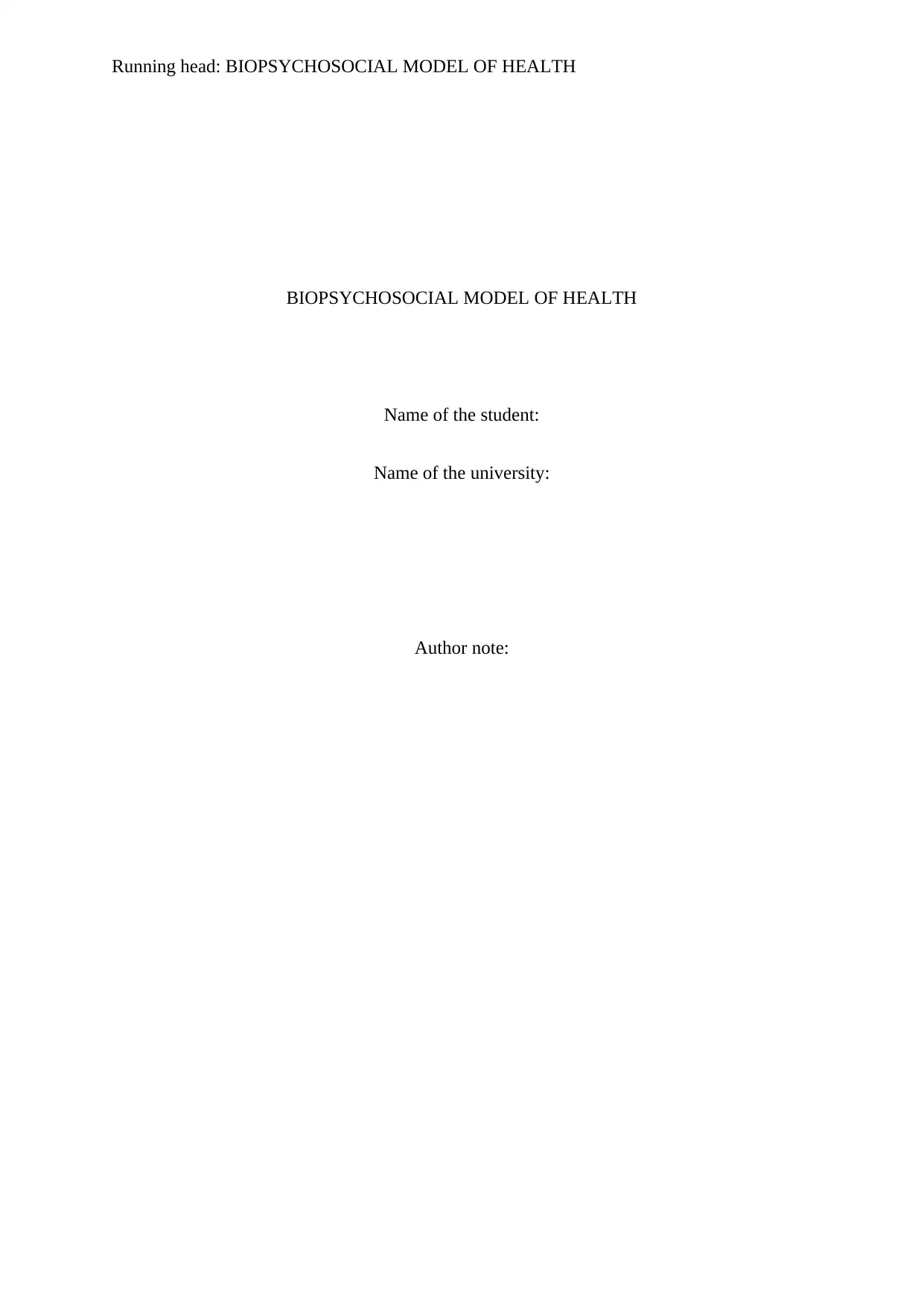
Running head: BIOPSYCHOSOCIAL MODEL OF HEALTH
BIOPSYCHOSOCIAL MODEL OF HEALTH
Name of the student:
Name of the university:
Author note:
BIOPSYCHOSOCIAL MODEL OF HEALTH
Name of the student:
Name of the university:
Author note:
Secure Best Marks with AI Grader
Need help grading? Try our AI Grader for instant feedback on your assignments.
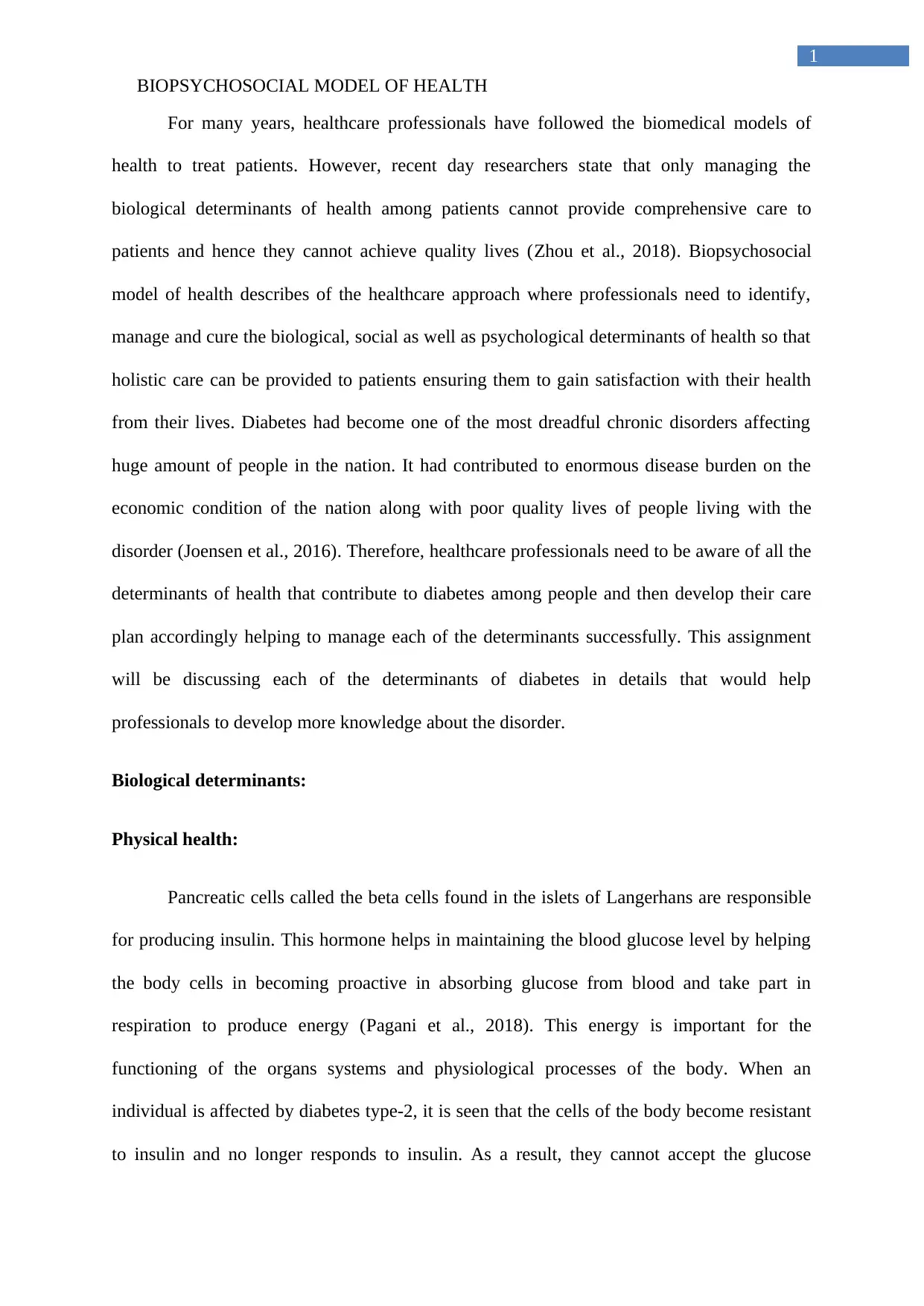
1
BIOPSYCHOSOCIAL MODEL OF HEALTH
For many years, healthcare professionals have followed the biomedical models of
health to treat patients. However, recent day researchers state that only managing the
biological determinants of health among patients cannot provide comprehensive care to
patients and hence they cannot achieve quality lives (Zhou et al., 2018). Biopsychosocial
model of health describes of the healthcare approach where professionals need to identify,
manage and cure the biological, social as well as psychological determinants of health so that
holistic care can be provided to patients ensuring them to gain satisfaction with their health
from their lives. Diabetes had become one of the most dreadful chronic disorders affecting
huge amount of people in the nation. It had contributed to enormous disease burden on the
economic condition of the nation along with poor quality lives of people living with the
disorder (Joensen et al., 2016). Therefore, healthcare professionals need to be aware of all the
determinants of health that contribute to diabetes among people and then develop their care
plan accordingly helping to manage each of the determinants successfully. This assignment
will be discussing each of the determinants of diabetes in details that would help
professionals to develop more knowledge about the disorder.
Biological determinants:
Physical health:
Pancreatic cells called the beta cells found in the islets of Langerhans are responsible
for producing insulin. This hormone helps in maintaining the blood glucose level by helping
the body cells in becoming proactive in absorbing glucose from blood and take part in
respiration to produce energy (Pagani et al., 2018). This energy is important for the
functioning of the organs systems and physiological processes of the body. When an
individual is affected by diabetes type-2, it is seen that the cells of the body become resistant
to insulin and no longer responds to insulin. As a result, they cannot accept the glucose
BIOPSYCHOSOCIAL MODEL OF HEALTH
For many years, healthcare professionals have followed the biomedical models of
health to treat patients. However, recent day researchers state that only managing the
biological determinants of health among patients cannot provide comprehensive care to
patients and hence they cannot achieve quality lives (Zhou et al., 2018). Biopsychosocial
model of health describes of the healthcare approach where professionals need to identify,
manage and cure the biological, social as well as psychological determinants of health so that
holistic care can be provided to patients ensuring them to gain satisfaction with their health
from their lives. Diabetes had become one of the most dreadful chronic disorders affecting
huge amount of people in the nation. It had contributed to enormous disease burden on the
economic condition of the nation along with poor quality lives of people living with the
disorder (Joensen et al., 2016). Therefore, healthcare professionals need to be aware of all the
determinants of health that contribute to diabetes among people and then develop their care
plan accordingly helping to manage each of the determinants successfully. This assignment
will be discussing each of the determinants of diabetes in details that would help
professionals to develop more knowledge about the disorder.
Biological determinants:
Physical health:
Pancreatic cells called the beta cells found in the islets of Langerhans are responsible
for producing insulin. This hormone helps in maintaining the blood glucose level by helping
the body cells in becoming proactive in absorbing glucose from blood and take part in
respiration to produce energy (Pagani et al., 2018). This energy is important for the
functioning of the organs systems and physiological processes of the body. When an
individual is affected by diabetes type-2, it is seen that the cells of the body become resistant
to insulin and no longer responds to insulin. As a result, they cannot accept the glucose

2
BIOPSYCHOSOCIAL MODEL OF HEALTH
present in the blood. Therefore, the blood glucose levels increases and the tissue systems start
getting deprived of energy and hence cannot function well. When insulin realised from
pancreatic cells also increases because of not being utilised by cells, they increase in amount.
This send negative feedback signals to pancreatic cells and this causes stopping of release of
insulin as well further worsening the conditions (Mehta & Kapoor, 2018). In course of time,
the organs start becoming deprived of energy and cannot function well resulting in various
forms of complications. Kidney disorders and nephropathy, neuropathy, eye disorders like
retinal neuropathy, glaucoma, foot ulcers and many others are seen to take place.
Genetic vulnerability:
Studies are of the opinion that individuals who are suffering from diabetes type-2
have higher chances that one or more people on their families have also suffered the same
disorder (Gemeay et al., 2015). Loose et al. (2018) had found that genetic mutations interact
with the environment as well as with each other’s thereby resulting in the increasing of the
risk factors for developing diabetes type-2 in individuals. They are also of the opinion that is
is not possible to separate the risk factors from the environmental risks as the latter gets
influences by the family members. For example, parents might pass on the habit of unhealthy
eating to their wards and this in turn might influence the mutated gene for effective digestion
procedure resulting in accumulation of fat and increasing chances of obesity and diabetes.
Different genes that are found to be mutated in diabetes individuals are the genes that help in
production of glucose, those associated with production and regulation of insulin, and those
which help in sensing glucose levels in the body (Kalra, Gupta & Das, 2015). Some genes
that have been found to be associated are TCF7L2 that affect secretion of insulin as well as
production of glucose, ABCC8 that helps in regulating insulin. Others are CAPN10 that
remains associated with type-2 diabetes as in case of Mexican Americans, GLUT2 that helps
in removing glucose into the pancreas. Thereby, genetic mutations along with influence from
BIOPSYCHOSOCIAL MODEL OF HEALTH
present in the blood. Therefore, the blood glucose levels increases and the tissue systems start
getting deprived of energy and hence cannot function well. When insulin realised from
pancreatic cells also increases because of not being utilised by cells, they increase in amount.
This send negative feedback signals to pancreatic cells and this causes stopping of release of
insulin as well further worsening the conditions (Mehta & Kapoor, 2018). In course of time,
the organs start becoming deprived of energy and cannot function well resulting in various
forms of complications. Kidney disorders and nephropathy, neuropathy, eye disorders like
retinal neuropathy, glaucoma, foot ulcers and many others are seen to take place.
Genetic vulnerability:
Studies are of the opinion that individuals who are suffering from diabetes type-2
have higher chances that one or more people on their families have also suffered the same
disorder (Gemeay et al., 2015). Loose et al. (2018) had found that genetic mutations interact
with the environment as well as with each other’s thereby resulting in the increasing of the
risk factors for developing diabetes type-2 in individuals. They are also of the opinion that is
is not possible to separate the risk factors from the environmental risks as the latter gets
influences by the family members. For example, parents might pass on the habit of unhealthy
eating to their wards and this in turn might influence the mutated gene for effective digestion
procedure resulting in accumulation of fat and increasing chances of obesity and diabetes.
Different genes that are found to be mutated in diabetes individuals are the genes that help in
production of glucose, those associated with production and regulation of insulin, and those
which help in sensing glucose levels in the body (Kalra, Gupta & Das, 2015). Some genes
that have been found to be associated are TCF7L2 that affect secretion of insulin as well as
production of glucose, ABCC8 that helps in regulating insulin. Others are CAPN10 that
remains associated with type-2 diabetes as in case of Mexican Americans, GLUT2 that helps
in removing glucose into the pancreas. Thereby, genetic mutations along with influence from
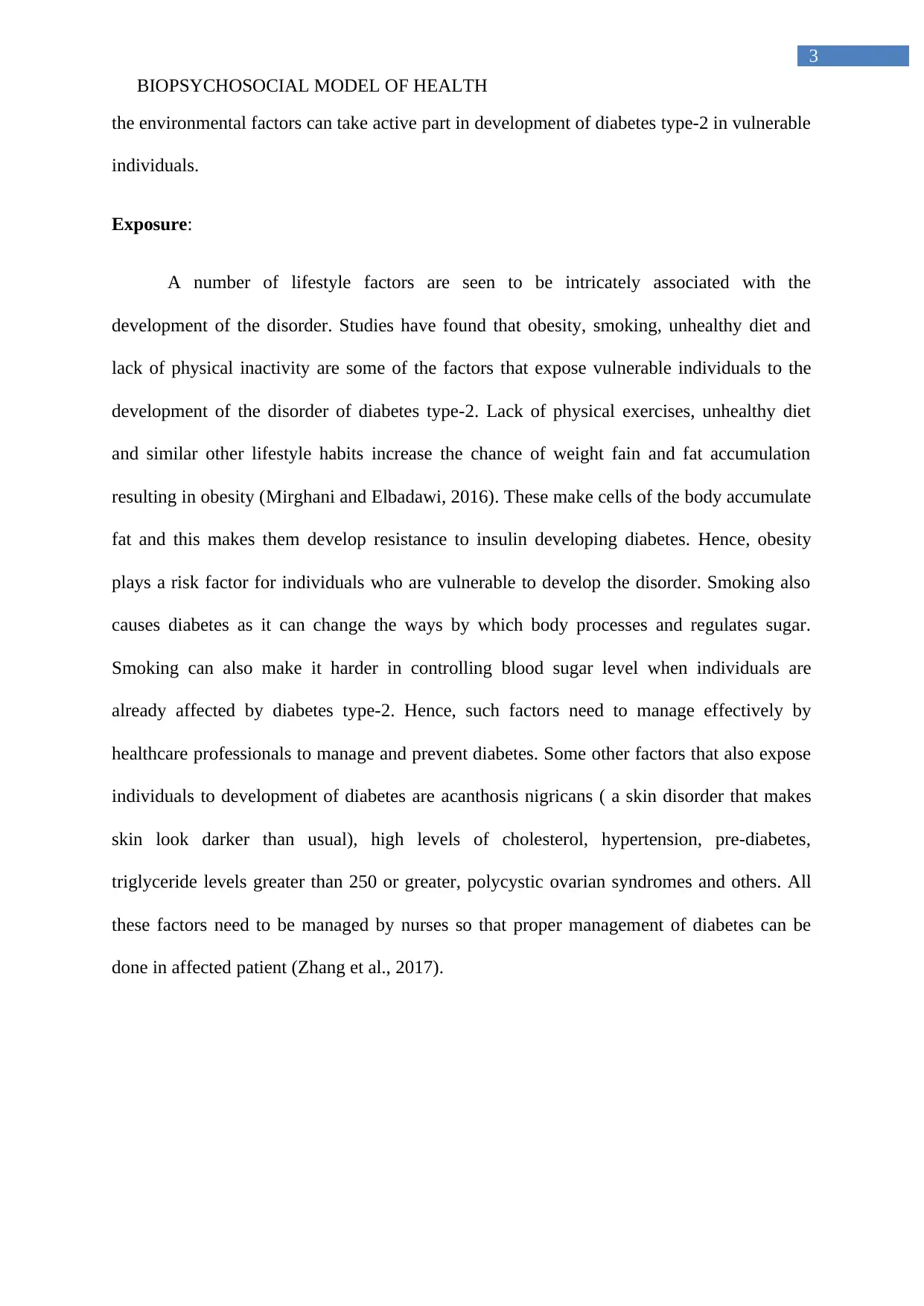
3
BIOPSYCHOSOCIAL MODEL OF HEALTH
the environmental factors can take active part in development of diabetes type-2 in vulnerable
individuals.
Exposure:
A number of lifestyle factors are seen to be intricately associated with the
development of the disorder. Studies have found that obesity, smoking, unhealthy diet and
lack of physical inactivity are some of the factors that expose vulnerable individuals to the
development of the disorder of diabetes type-2. Lack of physical exercises, unhealthy diet
and similar other lifestyle habits increase the chance of weight fain and fat accumulation
resulting in obesity (Mirghani and Elbadawi, 2016). These make cells of the body accumulate
fat and this makes them develop resistance to insulin developing diabetes. Hence, obesity
plays a risk factor for individuals who are vulnerable to develop the disorder. Smoking also
causes diabetes as it can change the ways by which body processes and regulates sugar.
Smoking can also make it harder in controlling blood sugar level when individuals are
already affected by diabetes type-2. Hence, such factors need to manage effectively by
healthcare professionals to manage and prevent diabetes. Some other factors that also expose
individuals to development of diabetes are acanthosis nigricans ( a skin disorder that makes
skin look darker than usual), high levels of cholesterol, hypertension, pre-diabetes,
triglyceride levels greater than 250 or greater, polycystic ovarian syndromes and others. All
these factors need to be managed by nurses so that proper management of diabetes can be
done in affected patient (Zhang et al., 2017).
BIOPSYCHOSOCIAL MODEL OF HEALTH
the environmental factors can take active part in development of diabetes type-2 in vulnerable
individuals.
Exposure:
A number of lifestyle factors are seen to be intricately associated with the
development of the disorder. Studies have found that obesity, smoking, unhealthy diet and
lack of physical inactivity are some of the factors that expose vulnerable individuals to the
development of the disorder of diabetes type-2. Lack of physical exercises, unhealthy diet
and similar other lifestyle habits increase the chance of weight fain and fat accumulation
resulting in obesity (Mirghani and Elbadawi, 2016). These make cells of the body accumulate
fat and this makes them develop resistance to insulin developing diabetes. Hence, obesity
plays a risk factor for individuals who are vulnerable to develop the disorder. Smoking also
causes diabetes as it can change the ways by which body processes and regulates sugar.
Smoking can also make it harder in controlling blood sugar level when individuals are
already affected by diabetes type-2. Hence, such factors need to manage effectively by
healthcare professionals to manage and prevent diabetes. Some other factors that also expose
individuals to development of diabetes are acanthosis nigricans ( a skin disorder that makes
skin look darker than usual), high levels of cholesterol, hypertension, pre-diabetes,
triglyceride levels greater than 250 or greater, polycystic ovarian syndromes and others. All
these factors need to be managed by nurses so that proper management of diabetes can be
done in affected patient (Zhang et al., 2017).
Secure Best Marks with AI Grader
Need help grading? Try our AI Grader for instant feedback on your assignments.

4
BIOPSYCHOSOCIAL MODEL OF HEALTH
Social determinants:
SES:
Studies have found that poor socioeconomic status also called (SES) to be intricately
associated with the development of diabetes type-2. People belonging to poverty cohort are
seen to face discriminations regarding equity and social justice in seeking healthcare services.
They do not have equal access to care. People belonging to such cohort are also seen to be
associated with lower education attainment, poor employment status, low health literacy
levels, poor housing, unhealthy mental stability and many others. Financial insecurity found
in such cohorts often makes them buy unhealthy cheap foods that are high in calories and
cause obesity that increases risk for diabetes (Burns et al., 2018). Lack of health literacy
found in such cohorts prevents them from undertaking correct healthcare decisions. Lack of
knowledge found in people from such background does not understand importance of
participating in screening sessions, education programs, seeking healthcare aides at right
time. Therefore, people with such backgrounds are found to be highly associated with the
disorders. People with SES also does not get equal healthcare opportunities like that of high
SES (high socioeconomic status) people because of lack of equity and equality in healthcare
services. Such factors need to be addressed while caring for affected individuals.
Peers:
Often influence of peers make individuals to get involved in different lifestyle choices
that increase the chances of people to become affected by diabetes type-2. Smoking, alcohol
intake, practice of eating unhealthy fast foods, being engaged in social media networks for
longer hours of days and many others make them develop diabetes directly and indirectly
(Elbadawi et al., 2016).
BIOPSYCHOSOCIAL MODEL OF HEALTH
Social determinants:
SES:
Studies have found that poor socioeconomic status also called (SES) to be intricately
associated with the development of diabetes type-2. People belonging to poverty cohort are
seen to face discriminations regarding equity and social justice in seeking healthcare services.
They do not have equal access to care. People belonging to such cohort are also seen to be
associated with lower education attainment, poor employment status, low health literacy
levels, poor housing, unhealthy mental stability and many others. Financial insecurity found
in such cohorts often makes them buy unhealthy cheap foods that are high in calories and
cause obesity that increases risk for diabetes (Burns et al., 2018). Lack of health literacy
found in such cohorts prevents them from undertaking correct healthcare decisions. Lack of
knowledge found in people from such background does not understand importance of
participating in screening sessions, education programs, seeking healthcare aides at right
time. Therefore, people with such backgrounds are found to be highly associated with the
disorders. People with SES also does not get equal healthcare opportunities like that of high
SES (high socioeconomic status) people because of lack of equity and equality in healthcare
services. Such factors need to be addressed while caring for affected individuals.
Peers:
Often influence of peers make individuals to get involved in different lifestyle choices
that increase the chances of people to become affected by diabetes type-2. Smoking, alcohol
intake, practice of eating unhealthy fast foods, being engaged in social media networks for
longer hours of days and many others make them develop diabetes directly and indirectly
(Elbadawi et al., 2016).
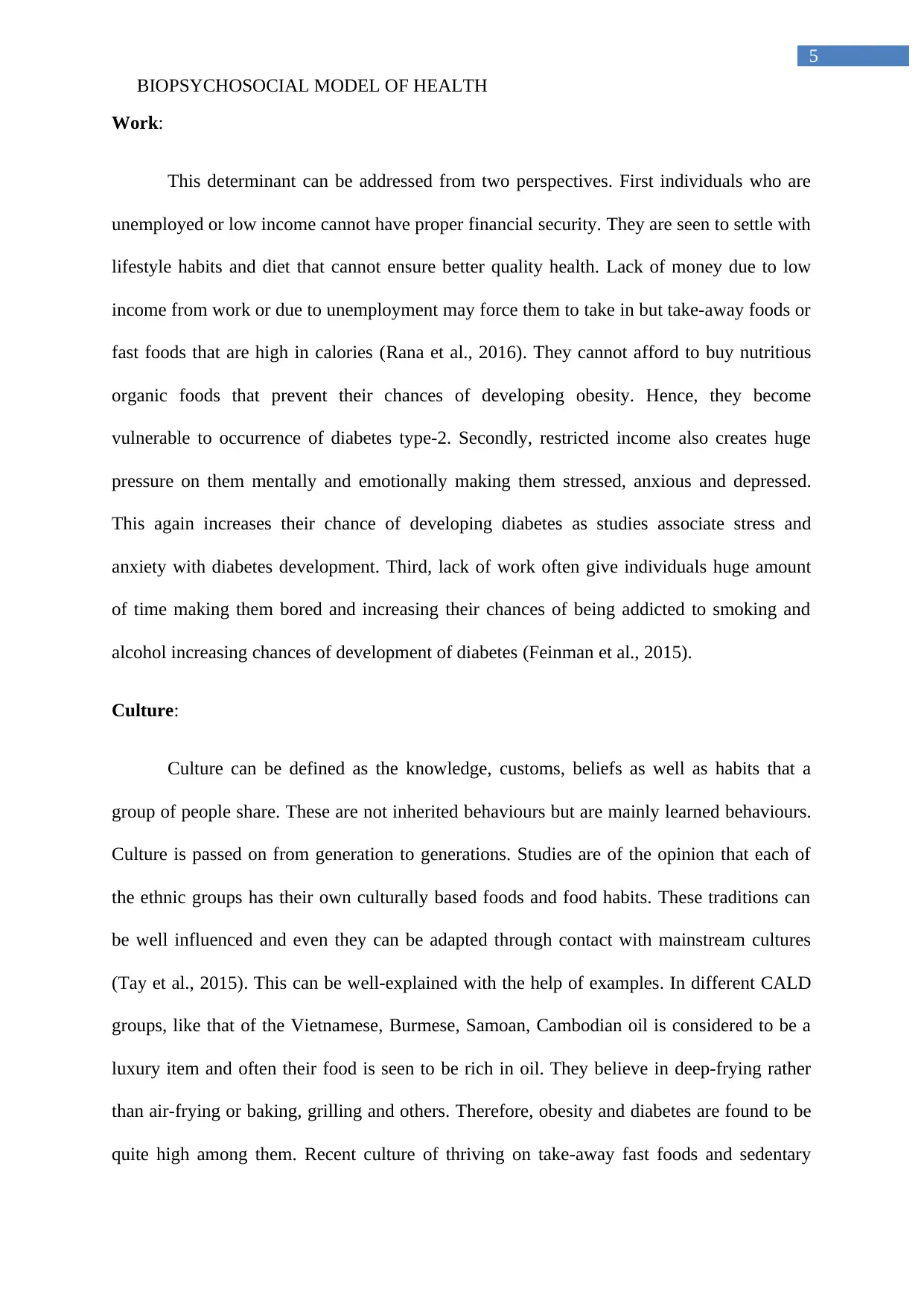
5
BIOPSYCHOSOCIAL MODEL OF HEALTH
Work:
This determinant can be addressed from two perspectives. First individuals who are
unemployed or low income cannot have proper financial security. They are seen to settle with
lifestyle habits and diet that cannot ensure better quality health. Lack of money due to low
income from work or due to unemployment may force them to take in but take-away foods or
fast foods that are high in calories (Rana et al., 2016). They cannot afford to buy nutritious
organic foods that prevent their chances of developing obesity. Hence, they become
vulnerable to occurrence of diabetes type-2. Secondly, restricted income also creates huge
pressure on them mentally and emotionally making them stressed, anxious and depressed.
This again increases their chance of developing diabetes as studies associate stress and
anxiety with diabetes development. Third, lack of work often give individuals huge amount
of time making them bored and increasing their chances of being addicted to smoking and
alcohol increasing chances of development of diabetes (Feinman et al., 2015).
Culture:
Culture can be defined as the knowledge, customs, beliefs as well as habits that a
group of people share. These are not inherited behaviours but are mainly learned behaviours.
Culture is passed on from generation to generations. Studies are of the opinion that each of
the ethnic groups has their own culturally based foods and food habits. These traditions can
be well influenced and even they can be adapted through contact with mainstream cultures
(Tay et al., 2015). This can be well-explained with the help of examples. In different CALD
groups, like that of the Vietnamese, Burmese, Samoan, Cambodian oil is considered to be a
luxury item and often their food is seen to be rich in oil. They believe in deep-frying rather
than air-frying or baking, grilling and others. Therefore, obesity and diabetes are found to be
quite high among them. Recent culture of thriving on take-away fast foods and sedentary
BIOPSYCHOSOCIAL MODEL OF HEALTH
Work:
This determinant can be addressed from two perspectives. First individuals who are
unemployed or low income cannot have proper financial security. They are seen to settle with
lifestyle habits and diet that cannot ensure better quality health. Lack of money due to low
income from work or due to unemployment may force them to take in but take-away foods or
fast foods that are high in calories (Rana et al., 2016). They cannot afford to buy nutritious
organic foods that prevent their chances of developing obesity. Hence, they become
vulnerable to occurrence of diabetes type-2. Secondly, restricted income also creates huge
pressure on them mentally and emotionally making them stressed, anxious and depressed.
This again increases their chance of developing diabetes as studies associate stress and
anxiety with diabetes development. Third, lack of work often give individuals huge amount
of time making them bored and increasing their chances of being addicted to smoking and
alcohol increasing chances of development of diabetes (Feinman et al., 2015).
Culture:
Culture can be defined as the knowledge, customs, beliefs as well as habits that a
group of people share. These are not inherited behaviours but are mainly learned behaviours.
Culture is passed on from generation to generations. Studies are of the opinion that each of
the ethnic groups has their own culturally based foods and food habits. These traditions can
be well influenced and even they can be adapted through contact with mainstream cultures
(Tay et al., 2015). This can be well-explained with the help of examples. In different CALD
groups, like that of the Vietnamese, Burmese, Samoan, Cambodian oil is considered to be a
luxury item and often their food is seen to be rich in oil. They believe in deep-frying rather
than air-frying or baking, grilling and others. Therefore, obesity and diabetes are found to be
quite high among them. Recent culture of thriving on take-away fast foods and sedentary
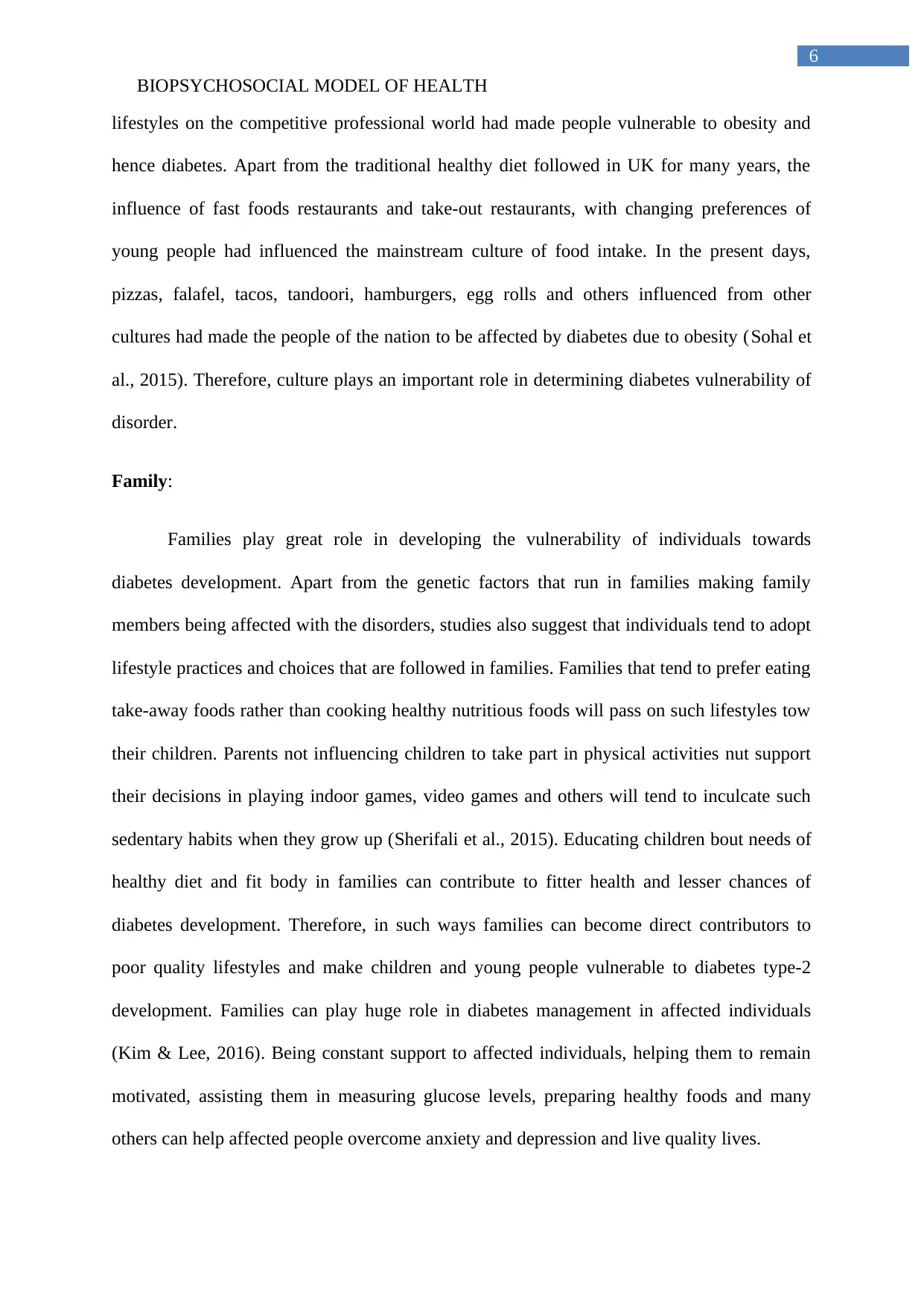
6
BIOPSYCHOSOCIAL MODEL OF HEALTH
lifestyles on the competitive professional world had made people vulnerable to obesity and
hence diabetes. Apart from the traditional healthy diet followed in UK for many years, the
influence of fast foods restaurants and take-out restaurants, with changing preferences of
young people had influenced the mainstream culture of food intake. In the present days,
pizzas, falafel, tacos, tandoori, hamburgers, egg rolls and others influenced from other
cultures had made the people of the nation to be affected by diabetes due to obesity (Sohal et
al., 2015). Therefore, culture plays an important role in determining diabetes vulnerability of
disorder.
Family:
Families play great role in developing the vulnerability of individuals towards
diabetes development. Apart from the genetic factors that run in families making family
members being affected with the disorders, studies also suggest that individuals tend to adopt
lifestyle practices and choices that are followed in families. Families that tend to prefer eating
take-away foods rather than cooking healthy nutritious foods will pass on such lifestyles tow
their children. Parents not influencing children to take part in physical activities nut support
their decisions in playing indoor games, video games and others will tend to inculcate such
sedentary habits when they grow up (Sherifali et al., 2015). Educating children bout needs of
healthy diet and fit body in families can contribute to fitter health and lesser chances of
diabetes development. Therefore, in such ways families can become direct contributors to
poor quality lifestyles and make children and young people vulnerable to diabetes type-2
development. Families can play huge role in diabetes management in affected individuals
(Kim & Lee, 2016). Being constant support to affected individuals, helping them to remain
motivated, assisting them in measuring glucose levels, preparing healthy foods and many
others can help affected people overcome anxiety and depression and live quality lives.
BIOPSYCHOSOCIAL MODEL OF HEALTH
lifestyles on the competitive professional world had made people vulnerable to obesity and
hence diabetes. Apart from the traditional healthy diet followed in UK for many years, the
influence of fast foods restaurants and take-out restaurants, with changing preferences of
young people had influenced the mainstream culture of food intake. In the present days,
pizzas, falafel, tacos, tandoori, hamburgers, egg rolls and others influenced from other
cultures had made the people of the nation to be affected by diabetes due to obesity (Sohal et
al., 2015). Therefore, culture plays an important role in determining diabetes vulnerability of
disorder.
Family:
Families play great role in developing the vulnerability of individuals towards
diabetes development. Apart from the genetic factors that run in families making family
members being affected with the disorders, studies also suggest that individuals tend to adopt
lifestyle practices and choices that are followed in families. Families that tend to prefer eating
take-away foods rather than cooking healthy nutritious foods will pass on such lifestyles tow
their children. Parents not influencing children to take part in physical activities nut support
their decisions in playing indoor games, video games and others will tend to inculcate such
sedentary habits when they grow up (Sherifali et al., 2015). Educating children bout needs of
healthy diet and fit body in families can contribute to fitter health and lesser chances of
diabetes development. Therefore, in such ways families can become direct contributors to
poor quality lifestyles and make children and young people vulnerable to diabetes type-2
development. Families can play huge role in diabetes management in affected individuals
(Kim & Lee, 2016). Being constant support to affected individuals, helping them to remain
motivated, assisting them in measuring glucose levels, preparing healthy foods and many
others can help affected people overcome anxiety and depression and live quality lives.
Paraphrase This Document
Need a fresh take? Get an instant paraphrase of this document with our AI Paraphraser
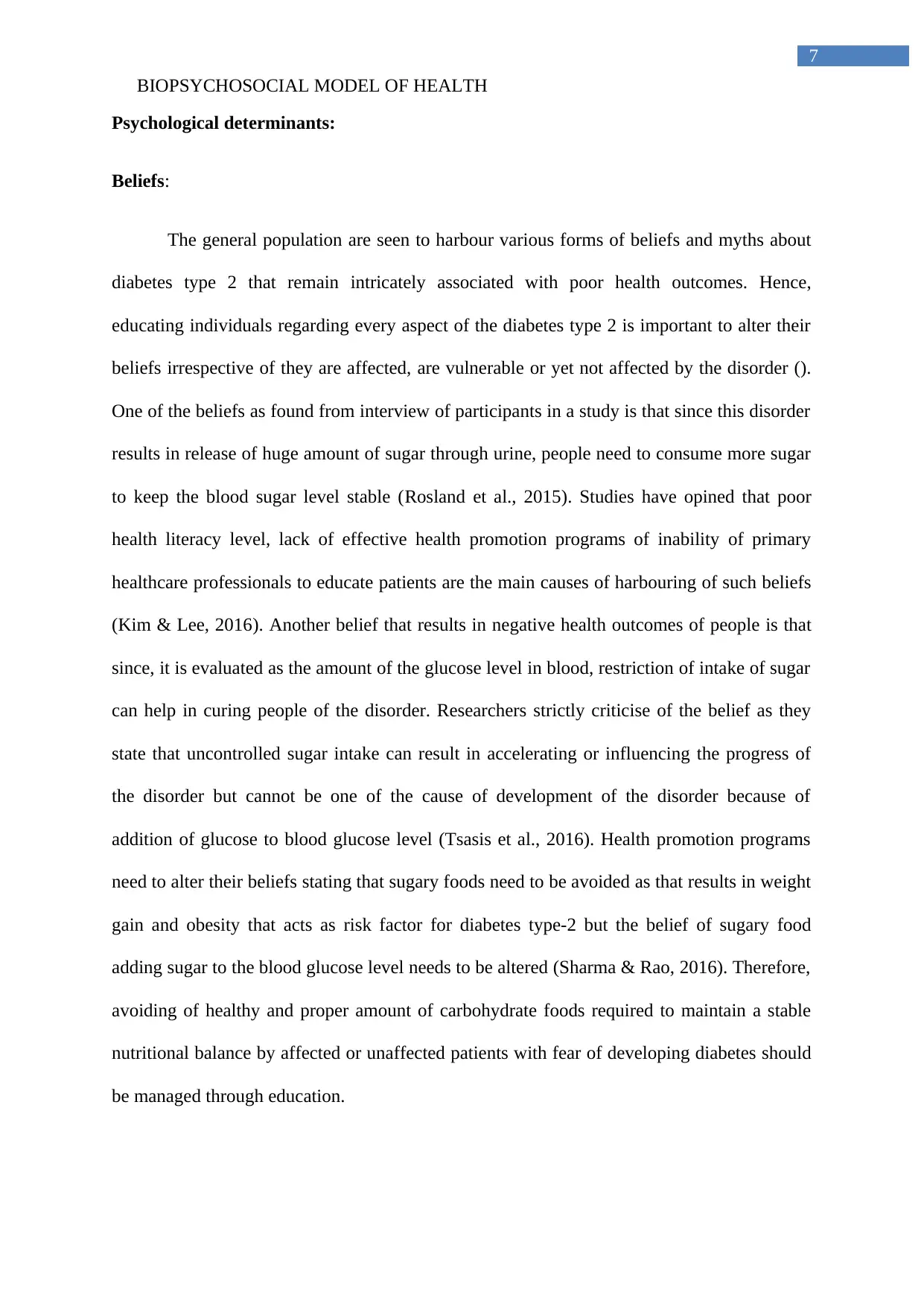
7
BIOPSYCHOSOCIAL MODEL OF HEALTH
Psychological determinants:
Beliefs:
The general population are seen to harbour various forms of beliefs and myths about
diabetes type 2 that remain intricately associated with poor health outcomes. Hence,
educating individuals regarding every aspect of the diabetes type 2 is important to alter their
beliefs irrespective of they are affected, are vulnerable or yet not affected by the disorder ().
One of the beliefs as found from interview of participants in a study is that since this disorder
results in release of huge amount of sugar through urine, people need to consume more sugar
to keep the blood sugar level stable (Rosland et al., 2015). Studies have opined that poor
health literacy level, lack of effective health promotion programs of inability of primary
healthcare professionals to educate patients are the main causes of harbouring of such beliefs
(Kim & Lee, 2016). Another belief that results in negative health outcomes of people is that
since, it is evaluated as the amount of the glucose level in blood, restriction of intake of sugar
can help in curing people of the disorder. Researchers strictly criticise of the belief as they
state that uncontrolled sugar intake can result in accelerating or influencing the progress of
the disorder but cannot be one of the cause of development of the disorder because of
addition of glucose to blood glucose level (Tsasis et al., 2016). Health promotion programs
need to alter their beliefs stating that sugary foods need to be avoided as that results in weight
gain and obesity that acts as risk factor for diabetes type-2 but the belief of sugary food
adding sugar to the blood glucose level needs to be altered (Sharma & Rao, 2016). Therefore,
avoiding of healthy and proper amount of carbohydrate foods required to maintain a stable
nutritional balance by affected or unaffected patients with fear of developing diabetes should
be managed through education.
BIOPSYCHOSOCIAL MODEL OF HEALTH
Psychological determinants:
Beliefs:
The general population are seen to harbour various forms of beliefs and myths about
diabetes type 2 that remain intricately associated with poor health outcomes. Hence,
educating individuals regarding every aspect of the diabetes type 2 is important to alter their
beliefs irrespective of they are affected, are vulnerable or yet not affected by the disorder ().
One of the beliefs as found from interview of participants in a study is that since this disorder
results in release of huge amount of sugar through urine, people need to consume more sugar
to keep the blood sugar level stable (Rosland et al., 2015). Studies have opined that poor
health literacy level, lack of effective health promotion programs of inability of primary
healthcare professionals to educate patients are the main causes of harbouring of such beliefs
(Kim & Lee, 2016). Another belief that results in negative health outcomes of people is that
since, it is evaluated as the amount of the glucose level in blood, restriction of intake of sugar
can help in curing people of the disorder. Researchers strictly criticise of the belief as they
state that uncontrolled sugar intake can result in accelerating or influencing the progress of
the disorder but cannot be one of the cause of development of the disorder because of
addition of glucose to blood glucose level (Tsasis et al., 2016). Health promotion programs
need to alter their beliefs stating that sugary foods need to be avoided as that results in weight
gain and obesity that acts as risk factor for diabetes type-2 but the belief of sugary food
adding sugar to the blood glucose level needs to be altered (Sharma & Rao, 2016). Therefore,
avoiding of healthy and proper amount of carbohydrate foods required to maintain a stable
nutritional balance by affected or unaffected patients with fear of developing diabetes should
be managed through education.
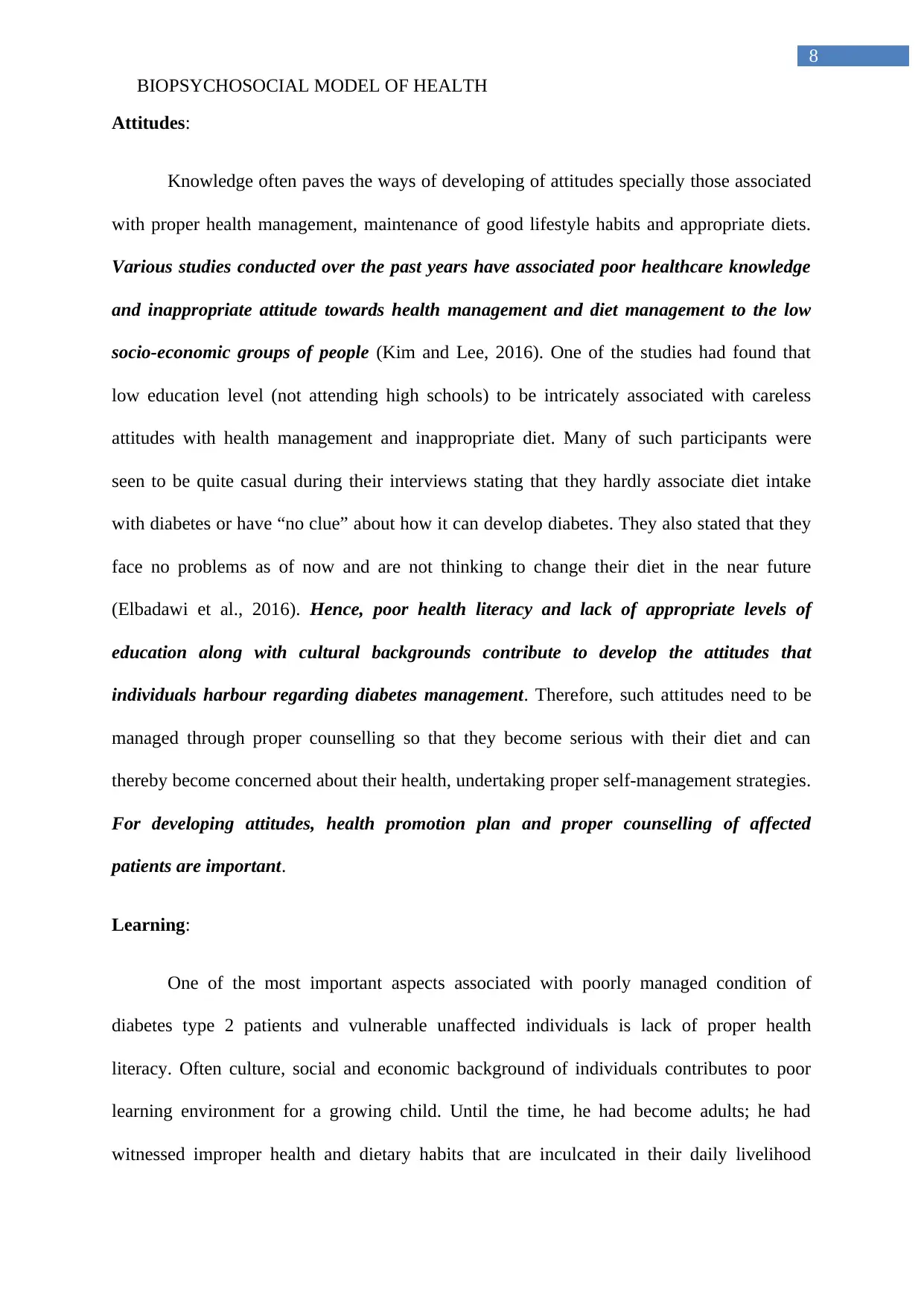
8
BIOPSYCHOSOCIAL MODEL OF HEALTH
Attitudes:
Knowledge often paves the ways of developing of attitudes specially those associated
with proper health management, maintenance of good lifestyle habits and appropriate diets.
Various studies conducted over the past years have associated poor healthcare knowledge
and inappropriate attitude towards health management and diet management to the low
socio-economic groups of people (Kim and Lee, 2016). One of the studies had found that
low education level (not attending high schools) to be intricately associated with careless
attitudes with health management and inappropriate diet. Many of such participants were
seen to be quite casual during their interviews stating that they hardly associate diet intake
with diabetes or have “no clue” about how it can develop diabetes. They also stated that they
face no problems as of now and are not thinking to change their diet in the near future
(Elbadawi et al., 2016). Hence, poor health literacy and lack of appropriate levels of
education along with cultural backgrounds contribute to develop the attitudes that
individuals harbour regarding diabetes management. Therefore, such attitudes need to be
managed through proper counselling so that they become serious with their diet and can
thereby become concerned about their health, undertaking proper self-management strategies.
For developing attitudes, health promotion plan and proper counselling of affected
patients are important.
Learning:
One of the most important aspects associated with poorly managed condition of
diabetes type 2 patients and vulnerable unaffected individuals is lack of proper health
literacy. Often culture, social and economic background of individuals contributes to poor
learning environment for a growing child. Until the time, he had become adults; he had
witnessed improper health and dietary habits that are inculcated in their daily livelihood
BIOPSYCHOSOCIAL MODEL OF HEALTH
Attitudes:
Knowledge often paves the ways of developing of attitudes specially those associated
with proper health management, maintenance of good lifestyle habits and appropriate diets.
Various studies conducted over the past years have associated poor healthcare knowledge
and inappropriate attitude towards health management and diet management to the low
socio-economic groups of people (Kim and Lee, 2016). One of the studies had found that
low education level (not attending high schools) to be intricately associated with careless
attitudes with health management and inappropriate diet. Many of such participants were
seen to be quite casual during their interviews stating that they hardly associate diet intake
with diabetes or have “no clue” about how it can develop diabetes. They also stated that they
face no problems as of now and are not thinking to change their diet in the near future
(Elbadawi et al., 2016). Hence, poor health literacy and lack of appropriate levels of
education along with cultural backgrounds contribute to develop the attitudes that
individuals harbour regarding diabetes management. Therefore, such attitudes need to be
managed through proper counselling so that they become serious with their diet and can
thereby become concerned about their health, undertaking proper self-management strategies.
For developing attitudes, health promotion plan and proper counselling of affected
patients are important.
Learning:
One of the most important aspects associated with poorly managed condition of
diabetes type 2 patients and vulnerable unaffected individuals is lack of proper health
literacy. Often culture, social and economic background of individuals contributes to poor
learning environment for a growing child. Until the time, he had become adults; he had
witnessed improper health and dietary habits that are inculcated in their daily livelihood

9
BIOPSYCHOSOCIAL MODEL OF HEALTH
(Elbadawi et al., 2016). This form of learning is called observational learning where
individuals learn from the environment around through effective observation. This is quite
different from the learning that occurs in schools and education centres through books
and journals. This can be explained with the help of example. A child who is growing up
observing family members to dine on fast foods high on calories would adopt the lifestyle
inevitably (Rana et al., 2016). Therefore, in addition to the learning about healthcare
management in schools and institutions, providing a child with proper environment that
promotes healthy eating and living behaviours with exercises can enable them in safe
living. Therefore, healthcare professionals need to alter both their literacy level and already
learned behaviours to develop confidence and motivation effectively for self-management
strategies.
Anxiety:
Studies have found anxiety as well as depression to be significant risk factors for the
development of diabetes (Burns et al., 2018). There had been conflicting opinions about this.
Many of the researchers believe that general anxiety does not cause diabetes but stress and
anxiety related to diabetes self-care and management attributes relate to improper blood
glucose management (Loose et al., 2018). People are said to face different concerns regarding
measuring levels of insulin, counting carbohydrates level regularly, long-term health impacts,
restricted lives and many others. On the other hand, others have argued that anxiety acts as
risk factor for diabetes. Studies have found that stress can result in increase in blood glucose
levels thereby making anxiety as one of contributing factor for the disorder (Kalra et al.,
2015). Although there are mixed opinion about the associations of anxiety and diabetes
type-2, healthcare professionals need to ensure management of anxiety among both
vulnerable and already affected individuals to prevent negative health outcomes on both
the cohorts.
BIOPSYCHOSOCIAL MODEL OF HEALTH
(Elbadawi et al., 2016). This form of learning is called observational learning where
individuals learn from the environment around through effective observation. This is quite
different from the learning that occurs in schools and education centres through books
and journals. This can be explained with the help of example. A child who is growing up
observing family members to dine on fast foods high on calories would adopt the lifestyle
inevitably (Rana et al., 2016). Therefore, in addition to the learning about healthcare
management in schools and institutions, providing a child with proper environment that
promotes healthy eating and living behaviours with exercises can enable them in safe
living. Therefore, healthcare professionals need to alter both their literacy level and already
learned behaviours to develop confidence and motivation effectively for self-management
strategies.
Anxiety:
Studies have found anxiety as well as depression to be significant risk factors for the
development of diabetes (Burns et al., 2018). There had been conflicting opinions about this.
Many of the researchers believe that general anxiety does not cause diabetes but stress and
anxiety related to diabetes self-care and management attributes relate to improper blood
glucose management (Loose et al., 2018). People are said to face different concerns regarding
measuring levels of insulin, counting carbohydrates level regularly, long-term health impacts,
restricted lives and many others. On the other hand, others have argued that anxiety acts as
risk factor for diabetes. Studies have found that stress can result in increase in blood glucose
levels thereby making anxiety as one of contributing factor for the disorder (Kalra et al.,
2015). Although there are mixed opinion about the associations of anxiety and diabetes
type-2, healthcare professionals need to ensure management of anxiety among both
vulnerable and already affected individuals to prevent negative health outcomes on both
the cohorts.
Secure Best Marks with AI Grader
Need help grading? Try our AI Grader for instant feedback on your assignments.
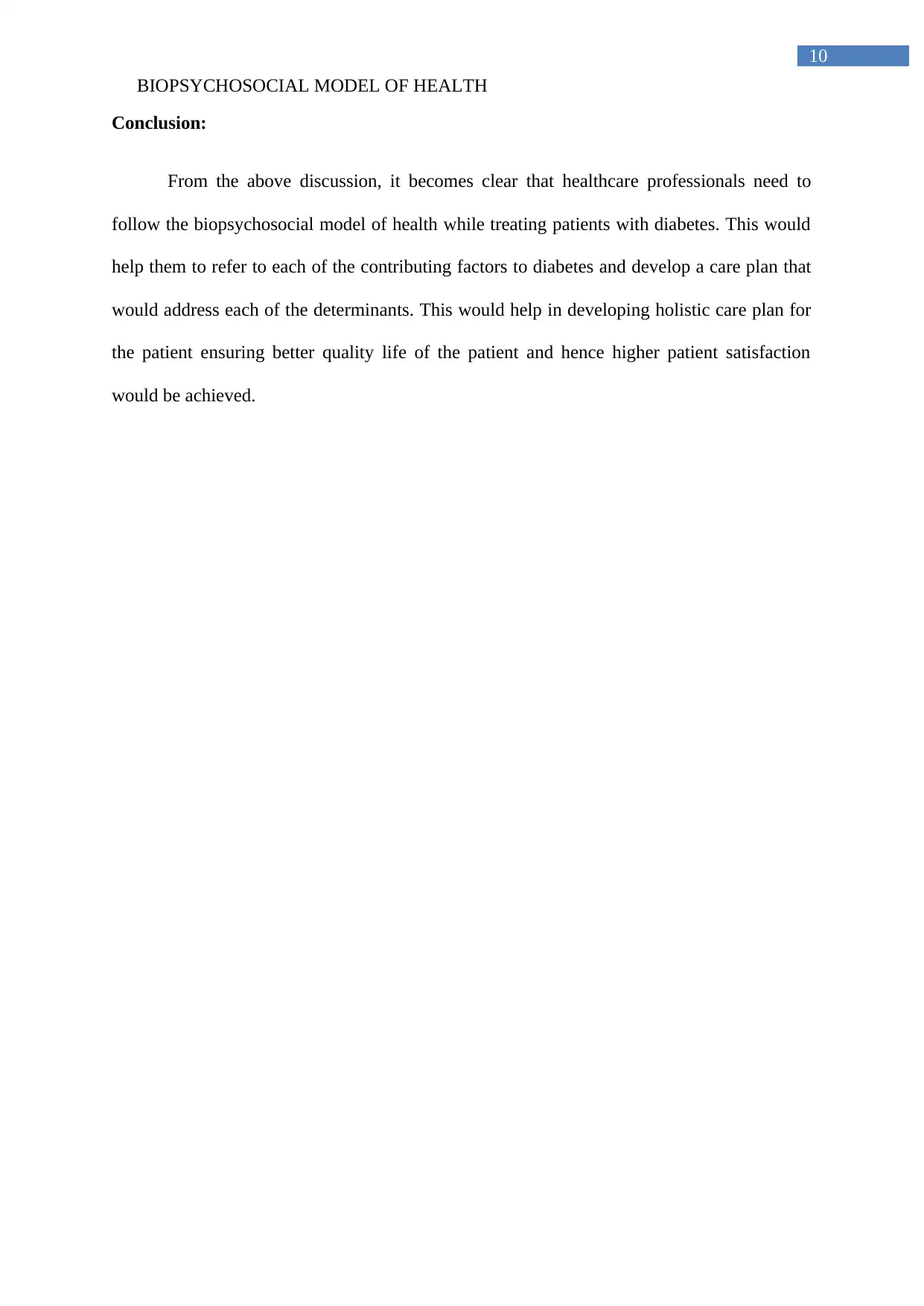
10
BIOPSYCHOSOCIAL MODEL OF HEALTH
Conclusion:
From the above discussion, it becomes clear that healthcare professionals need to
follow the biopsychosocial model of health while treating patients with diabetes. This would
help them to refer to each of the contributing factors to diabetes and develop a care plan that
would address each of the determinants. This would help in developing holistic care plan for
the patient ensuring better quality life of the patient and hence higher patient satisfaction
would be achieved.
BIOPSYCHOSOCIAL MODEL OF HEALTH
Conclusion:
From the above discussion, it becomes clear that healthcare professionals need to
follow the biopsychosocial model of health while treating patients with diabetes. This would
help them to refer to each of the contributing factors to diabetes and develop a care plan that
would address each of the determinants. This would help in developing holistic care plan for
the patient ensuring better quality life of the patient and hence higher patient satisfaction
would be achieved.
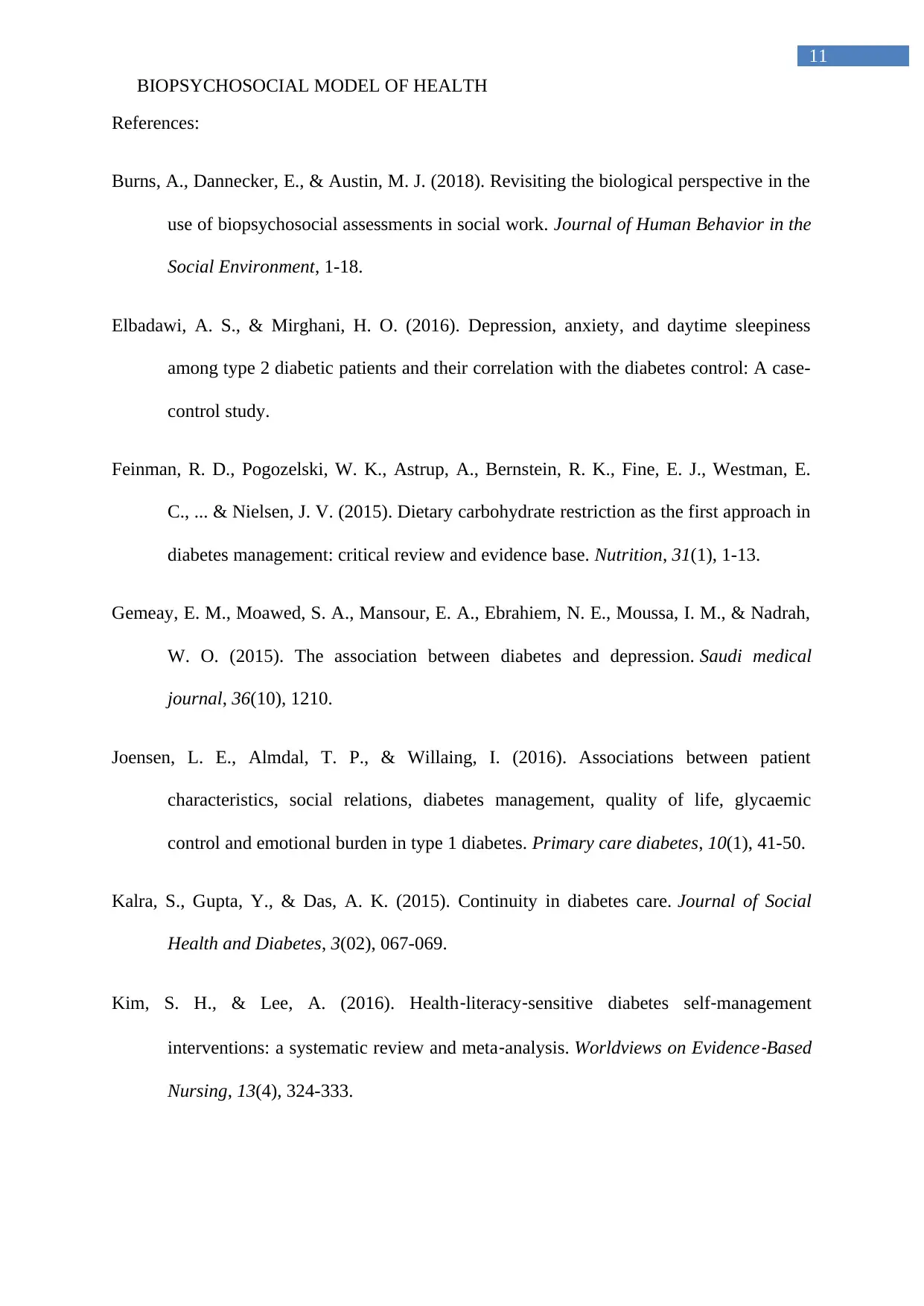
11
BIOPSYCHOSOCIAL MODEL OF HEALTH
References:
Burns, A., Dannecker, E., & Austin, M. J. (2018). Revisiting the biological perspective in the
use of biopsychosocial assessments in social work. Journal of Human Behavior in the
Social Environment, 1-18.
Elbadawi, A. S., & Mirghani, H. O. (2016). Depression, anxiety, and daytime sleepiness
among type 2 diabetic patients and their correlation with the diabetes control: A case-
control study.
Feinman, R. D., Pogozelski, W. K., Astrup, A., Bernstein, R. K., Fine, E. J., Westman, E.
C., ... & Nielsen, J. V. (2015). Dietary carbohydrate restriction as the first approach in
diabetes management: critical review and evidence base. Nutrition, 31(1), 1-13.
Gemeay, E. M., Moawed, S. A., Mansour, E. A., Ebrahiem, N. E., Moussa, I. M., & Nadrah,
W. O. (2015). The association between diabetes and depression. Saudi medical
journal, 36(10), 1210.
Joensen, L. E., Almdal, T. P., & Willaing, I. (2016). Associations between patient
characteristics, social relations, diabetes management, quality of life, glycaemic
control and emotional burden in type 1 diabetes. Primary care diabetes, 10(1), 41-50.
Kalra, S., Gupta, Y., & Das, A. K. (2015). Continuity in diabetes care. Journal of Social
Health and Diabetes, 3(02), 067-069.
Kim, S. H., & Lee, A. (2016). Health‐literacy‐sensitive diabetes self‐management
interventions: a systematic review and meta‐analysis. Worldviews on Evidence
‐Based
Nursing, 13(4), 324-333.
BIOPSYCHOSOCIAL MODEL OF HEALTH
References:
Burns, A., Dannecker, E., & Austin, M. J. (2018). Revisiting the biological perspective in the
use of biopsychosocial assessments in social work. Journal of Human Behavior in the
Social Environment, 1-18.
Elbadawi, A. S., & Mirghani, H. O. (2016). Depression, anxiety, and daytime sleepiness
among type 2 diabetic patients and their correlation with the diabetes control: A case-
control study.
Feinman, R. D., Pogozelski, W. K., Astrup, A., Bernstein, R. K., Fine, E. J., Westman, E.
C., ... & Nielsen, J. V. (2015). Dietary carbohydrate restriction as the first approach in
diabetes management: critical review and evidence base. Nutrition, 31(1), 1-13.
Gemeay, E. M., Moawed, S. A., Mansour, E. A., Ebrahiem, N. E., Moussa, I. M., & Nadrah,
W. O. (2015). The association between diabetes and depression. Saudi medical
journal, 36(10), 1210.
Joensen, L. E., Almdal, T. P., & Willaing, I. (2016). Associations between patient
characteristics, social relations, diabetes management, quality of life, glycaemic
control and emotional burden in type 1 diabetes. Primary care diabetes, 10(1), 41-50.
Kalra, S., Gupta, Y., & Das, A. K. (2015). Continuity in diabetes care. Journal of Social
Health and Diabetes, 3(02), 067-069.
Kim, S. H., & Lee, A. (2016). Health‐literacy‐sensitive diabetes self‐management
interventions: a systematic review and meta‐analysis. Worldviews on Evidence
‐Based
Nursing, 13(4), 324-333.
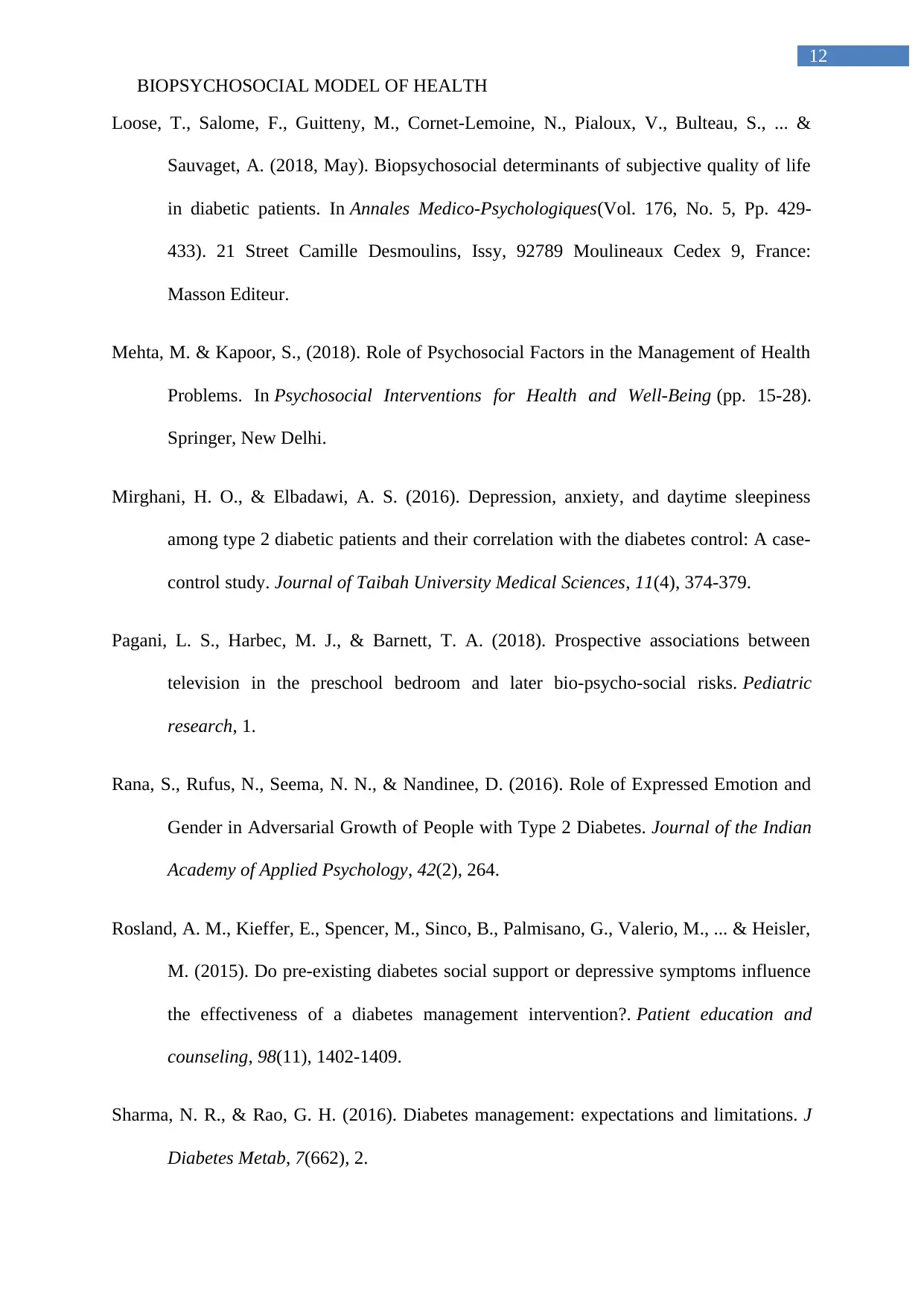
12
BIOPSYCHOSOCIAL MODEL OF HEALTH
Loose, T., Salome, F., Guitteny, M., Cornet-Lemoine, N., Pialoux, V., Bulteau, S., ... &
Sauvaget, A. (2018, May). Biopsychosocial determinants of subjective quality of life
in diabetic patients. In Annales Medico-Psychologiques(Vol. 176, No. 5, Pp. 429-
433). 21 Street Camille Desmoulins, Issy, 92789 Moulineaux Cedex 9, France:
Masson Editeur.
Mehta, M. & Kapoor, S., (2018). Role of Psychosocial Factors in the Management of Health
Problems. In Psychosocial Interventions for Health and Well-Being (pp. 15-28).
Springer, New Delhi.
Mirghani, H. O., & Elbadawi, A. S. (2016). Depression, anxiety, and daytime sleepiness
among type 2 diabetic patients and their correlation with the diabetes control: A case-
control study. Journal of Taibah University Medical Sciences, 11(4), 374-379.
Pagani, L. S., Harbec, M. J., & Barnett, T. A. (2018). Prospective associations between
television in the preschool bedroom and later bio-psycho-social risks. Pediatric
research, 1.
Rana, S., Rufus, N., Seema, N. N., & Nandinee, D. (2016). Role of Expressed Emotion and
Gender in Adversarial Growth of People with Type 2 Diabetes. Journal of the Indian
Academy of Applied Psychology, 42(2), 264.
Rosland, A. M., Kieffer, E., Spencer, M., Sinco, B., Palmisano, G., Valerio, M., ... & Heisler,
M. (2015). Do pre-existing diabetes social support or depressive symptoms influence
the effectiveness of a diabetes management intervention?. Patient education and
counseling, 98(11), 1402-1409.
Sharma, N. R., & Rao, G. H. (2016). Diabetes management: expectations and limitations. J
Diabetes Metab, 7(662), 2.
BIOPSYCHOSOCIAL MODEL OF HEALTH
Loose, T., Salome, F., Guitteny, M., Cornet-Lemoine, N., Pialoux, V., Bulteau, S., ... &
Sauvaget, A. (2018, May). Biopsychosocial determinants of subjective quality of life
in diabetic patients. In Annales Medico-Psychologiques(Vol. 176, No. 5, Pp. 429-
433). 21 Street Camille Desmoulins, Issy, 92789 Moulineaux Cedex 9, France:
Masson Editeur.
Mehta, M. & Kapoor, S., (2018). Role of Psychosocial Factors in the Management of Health
Problems. In Psychosocial Interventions for Health and Well-Being (pp. 15-28).
Springer, New Delhi.
Mirghani, H. O., & Elbadawi, A. S. (2016). Depression, anxiety, and daytime sleepiness
among type 2 diabetic patients and their correlation with the diabetes control: A case-
control study. Journal of Taibah University Medical Sciences, 11(4), 374-379.
Pagani, L. S., Harbec, M. J., & Barnett, T. A. (2018). Prospective associations between
television in the preschool bedroom and later bio-psycho-social risks. Pediatric
research, 1.
Rana, S., Rufus, N., Seema, N. N., & Nandinee, D. (2016). Role of Expressed Emotion and
Gender in Adversarial Growth of People with Type 2 Diabetes. Journal of the Indian
Academy of Applied Psychology, 42(2), 264.
Rosland, A. M., Kieffer, E., Spencer, M., Sinco, B., Palmisano, G., Valerio, M., ... & Heisler,
M. (2015). Do pre-existing diabetes social support or depressive symptoms influence
the effectiveness of a diabetes management intervention?. Patient education and
counseling, 98(11), 1402-1409.
Sharma, N. R., & Rao, G. H. (2016). Diabetes management: expectations and limitations. J
Diabetes Metab, 7(662), 2.
Paraphrase This Document
Need a fresh take? Get an instant paraphrase of this document with our AI Paraphraser
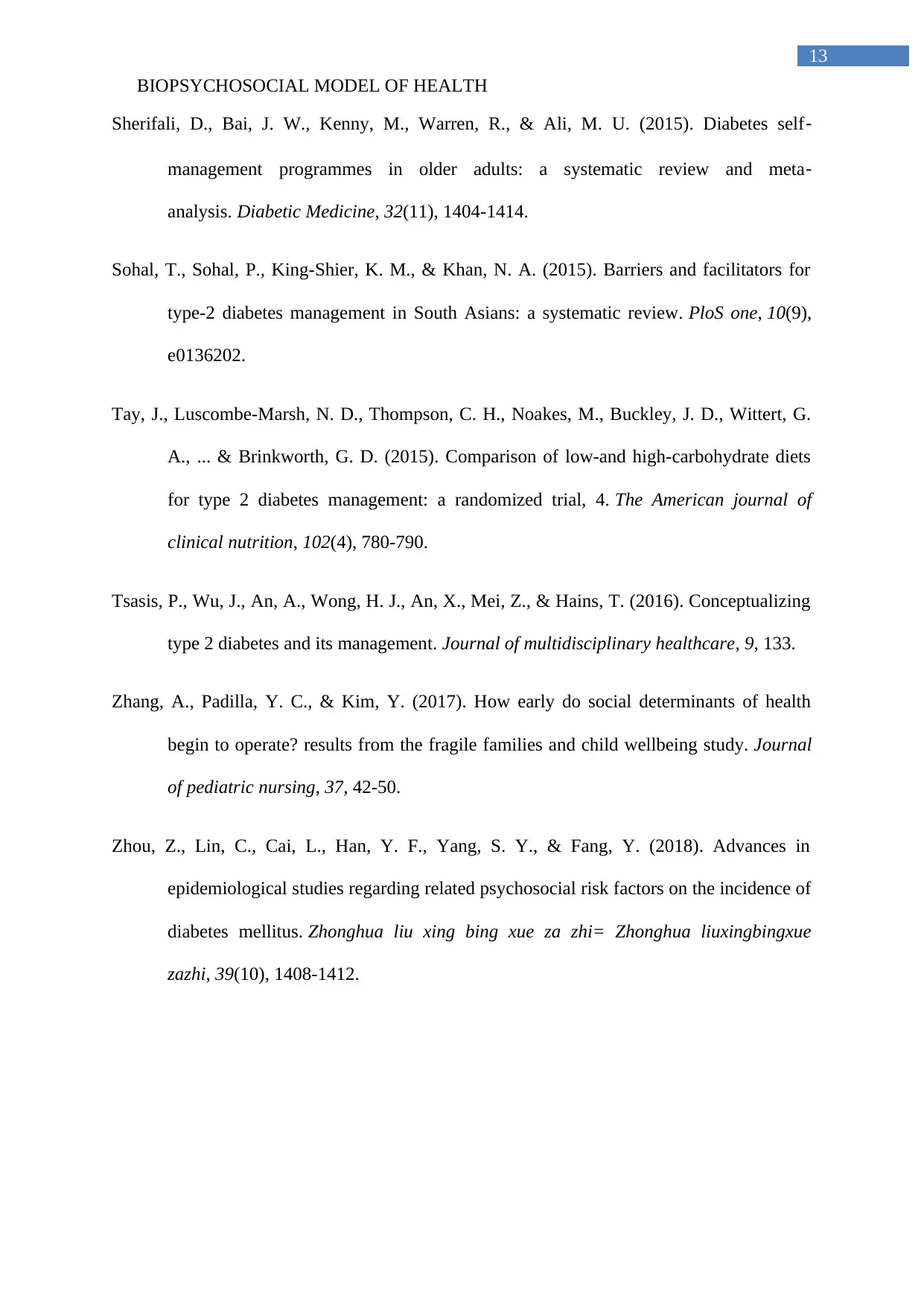
13
BIOPSYCHOSOCIAL MODEL OF HEALTH
Sherifali, D., Bai, J. W., Kenny, M., Warren, R., & Ali, M. U. (2015). Diabetes self‐
management programmes in older adults: a systematic review and meta‐
analysis. Diabetic Medicine, 32(11), 1404-1414.
Sohal, T., Sohal, P., King-Shier, K. M., & Khan, N. A. (2015). Barriers and facilitators for
type-2 diabetes management in South Asians: a systematic review. PloS one, 10(9),
e0136202.
Tay, J., Luscombe-Marsh, N. D., Thompson, C. H., Noakes, M., Buckley, J. D., Wittert, G.
A., ... & Brinkworth, G. D. (2015). Comparison of low-and high-carbohydrate diets
for type 2 diabetes management: a randomized trial, 4. The American journal of
clinical nutrition, 102(4), 780-790.
Tsasis, P., Wu, J., An, A., Wong, H. J., An, X., Mei, Z., & Hains, T. (2016). Conceptualizing
type 2 diabetes and its management. Journal of multidisciplinary healthcare, 9, 133.
Zhang, A., Padilla, Y. C., & Kim, Y. (2017). How early do social determinants of health
begin to operate? results from the fragile families and child wellbeing study. Journal
of pediatric nursing, 37, 42-50.
Zhou, Z., Lin, C., Cai, L., Han, Y. F., Yang, S. Y., & Fang, Y. (2018). Advances in
epidemiological studies regarding related psychosocial risk factors on the incidence of
diabetes mellitus. Zhonghua liu xing bing xue za zhi= Zhonghua liuxingbingxue
zazhi, 39(10), 1408-1412.
BIOPSYCHOSOCIAL MODEL OF HEALTH
Sherifali, D., Bai, J. W., Kenny, M., Warren, R., & Ali, M. U. (2015). Diabetes self‐
management programmes in older adults: a systematic review and meta‐
analysis. Diabetic Medicine, 32(11), 1404-1414.
Sohal, T., Sohal, P., King-Shier, K. M., & Khan, N. A. (2015). Barriers and facilitators for
type-2 diabetes management in South Asians: a systematic review. PloS one, 10(9),
e0136202.
Tay, J., Luscombe-Marsh, N. D., Thompson, C. H., Noakes, M., Buckley, J. D., Wittert, G.
A., ... & Brinkworth, G. D. (2015). Comparison of low-and high-carbohydrate diets
for type 2 diabetes management: a randomized trial, 4. The American journal of
clinical nutrition, 102(4), 780-790.
Tsasis, P., Wu, J., An, A., Wong, H. J., An, X., Mei, Z., & Hains, T. (2016). Conceptualizing
type 2 diabetes and its management. Journal of multidisciplinary healthcare, 9, 133.
Zhang, A., Padilla, Y. C., & Kim, Y. (2017). How early do social determinants of health
begin to operate? results from the fragile families and child wellbeing study. Journal
of pediatric nursing, 37, 42-50.
Zhou, Z., Lin, C., Cai, L., Han, Y. F., Yang, S. Y., & Fang, Y. (2018). Advances in
epidemiological studies regarding related psychosocial risk factors on the incidence of
diabetes mellitus. Zhonghua liu xing bing xue za zhi= Zhonghua liuxingbingxue
zazhi, 39(10), 1408-1412.
1 out of 14
Related Documents
Your All-in-One AI-Powered Toolkit for Academic Success.
+13062052269
info@desklib.com
Available 24*7 on WhatsApp / Email
![[object Object]](/_next/static/media/star-bottom.7253800d.svg)
Unlock your academic potential
© 2024 | Zucol Services PVT LTD | All rights reserved.





